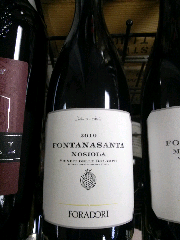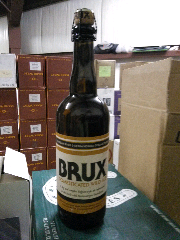 I taste a lot of wine for work. Hundreds, maybe into the four digit range per year, and a surprising amount of them are at best uninteresting and at worst just plain bad. The upshot is the good, and rarer yet, truly special wines I taste at the store.
I taste a lot of wine for work. Hundreds, maybe into the four digit range per year, and a surprising amount of them are at best uninteresting and at worst just plain bad. The upshot is the good, and rarer yet, truly special wines I taste at the store.And thus we segue in a most unsubtle way into the wine of Elisabetta Foradori. Elisabetta is a producer based around the Dolomite mountains in Alto Adige (sometimes referred to as Sudtirol or South Tyrol) in Italy. Having never been there, I can only gather so much from photos and information about the region, but it seems like an idyllic Alpine setting; of course I investigated how the climbing looks, and it looks good. Single & multi-pitch sport routes, short approaches... I digress.
Elisabetta has been in the work of growing grapes and making wine essentially for her entire life; she was born in a house surrounded by vineyards and took over as winemaker after an education at a local enological school and the untimely death of her father when she was only 20 years old.
Her bread & butter wine is made from the local grape teroldego. She has 18ha (44.5 acres) of this red grape that makes fresh, bright, and fruity red wines that have a natural high acidity and would undoubtedly pair well with the local speck (salt cured & smoked ham flavored primarily with juniper.)
What we decided to crack open the other day was her nosiola. Nosiola is a local varietal that was close to being forgotten, but she is taking efforts to keep it alive. She has but two hectares of nosiola, a 9th of teroldego plantings, but according to an interview with her, she has real fun with her white varietals (the other is manzoni bianco) because they’re relatively unknowns with “a lot of personality.”
Most of the time, when making white wine, the juice is pressed and removed from the skins of the grapes. Ms. Foradori however, leaves the juice on the skins in clay amphorae for 8 months which creates a wine with a slightly hazy appearance, a hint of pear-skin like tannins on the finish, and some freakin’ delicious flavors.
The wines aren’t cheap, the manzoni bianco is in the mid $30’s and the nosiola is about $54, but if the nosiola is any indication, Elisabetta makes truly special wines that are worth every penny. Now I just have to track down some of that teroldego.
 Brux & Branca, by which I refer to two disparate but intriguing items. Item one: the collaboration beer between Sierra Nevada & Russian River Brewing co. Item two: the Italian liquer Fernet Branca which takes its name from the eponymous amaro. They are completely unrelated, but I liked the alliteration.
Brux & Branca, by which I refer to two disparate but intriguing items. Item one: the collaboration beer between Sierra Nevada & Russian River Brewing co. Item two: the Italian liquer Fernet Branca which takes its name from the eponymous amaro. They are completely unrelated, but I liked the alliteration. Personally I find it difficult to get real jazzed about wine from New Zealand. I think there's loads of potential for very interesting wine, but as of yet it's not the first wine region I go hunting for on a wine list. But in with the goal of keeping an open mind we had a tasting at the store the other night, here's the list:
Personally I find it difficult to get real jazzed about wine from New Zealand. I think there's loads of potential for very interesting wine, but as of yet it's not the first wine region I go hunting for on a wine list. But in with the goal of keeping an open mind we had a tasting at the store the other night, here's the list: The other day Beth & I were struck with the desire for lasagna and I was looking for an excuse to open this bottle of 2008 Salvarenza from
The other day Beth & I were struck with the desire for lasagna and I was looking for an excuse to open this bottle of 2008 Salvarenza from